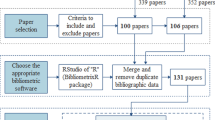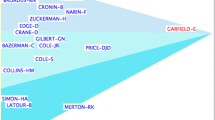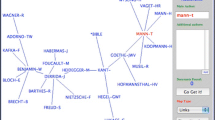Abstract
Citations networks are a core topic of informetrics and science studies. This article proposes to bridge the cited and citing side of citation transactions by using a disaggregated form, the “referencing-structure” function (RSF). The RSF may be also seen as the “retrieval-structure” which, in a stylized co-citation or co-word model, gives the maximum retrieval that can be expected from the bibliometric characteristics of the field (retrieval and recall features are key issues in co-citation studies). The usual citation and reference distributions may be derived from aggregates or cuts respectively, of the RSF. The RSF representation also generates new points of views on the citing-cited distributions, such as the "iso-retrieval function". A rank version of RSF is also introduced. Part I is devoted to the definition and construction of the RSF, and to the general interpretation of its various aspects in the context of co-citation studies. Generalization to other co-item (co-word, hyperlinks “co-sitations”) studies is discussed briefly. We also introduce a general form a kindred to the Weibull distribution that can be used to fit cuts of the function. The forthcoming Part II will detail empirical fits, using a few experimental files.
Similar content being viewed by others
References
EGGHE L. (1990), The duality of informetric systems with applications to the empirical laws. Journal of Information Science, 16: 17–27.
EGGHE, L., ROUSSEAU, R. (1990), Introduction to Infometrics. Quantitative Methods in Library, Documentation and Information Science. Elsevier, Amsterdam, Netherlands.
GLäNZEL W., SCHUBERT A. (1989), The Cumulative Advantage Function. A Mathematical Formulation Based on Conditional Expectations and its Application to Scientometric Distributions. Presented at The 2nd International Conference on Bibliometrics, Scientometrics and Informetrics, July 1989, London, Ontario, Canada.
GARFIELD E. (1998), Random thoughts on citationology. Its theory and practice. Scientometrics, 43: 69–76.
HAITUN, S. D. (1982a), Stationary scientometric distributions. Part I. Different approximations. Scientometrics, 4: 5–25.
HICKS, D. (1988), Limitations and more limitations of co-citation analysis as a tools for science policy. Social Studies of Science, 18: 375–384.
LEYDESDORFF L. (1998), Theories of citation ? Scientometrics, 43: 5–25 (Topical discussion issue on theories of citation).
MARSHAKOVA, I. V. (1973), Document coupling system based on references taken from Science Citation Index (in Russian). Nauchno-Teknicheskaya Informatsiya, Ser. 2, (6): 3.
MURUGESAN P., MORAVCSIK M. J. (1978), Variation of nature of citation measures with journals and scientific disciplines. Journal of the American Society for Information Science, 28: 141–155.
NARANAN S., Power-law relations in bibliography-a self-consistent interpretation. Journal of Documentation, 27: 83–97.
PRICE, D. J. DE S. (1976), A general theory of bibliometric and other cumulative advantage processes. Journal of the American Society for Information Science, 27: 292–306.
PRIME C., BASSECOULARD, E., ZITT, M. (2002), Citations and sitations: a cautionary view on an analogy, Scientometrics, 54: 291–308.
QUONIAM L., BALME F., ROSTAING H., GIRAUD E., DOU J. M. (1997), Bibliometric Law used for Information Retrieval. In: PERITZ, B., EGGHE, L. (Eds), Proceedings of the 6th Conference of the International Society for Scientometrics and Informetrics, Jerusalem, pp. 331–340.
RAMANANA-RAHARY S. (1996), Modélisation d'un processus dual: l'émission et la réception de citations, unpublished DEA dissertation, Univ Paris-Sud/ INRA-Lereco, France.
SALTON G., WU H. (1981), A term weighting model based on utility theory. In: VAN RIJSBERGEN C. J. (Ed.), Information Retrieval Research, Butterworth, pp. 9–21.
SAVOY J. (1996), Citation schemes in hypertext information retrieval. In: AGOSTI M., SMEATON A. (Eds), Information Retrieval and Hypertext, Kluwer, pp. 99–120.
SICHEL, H. S. (1992), Note on a strongly unimodal bibliometric size frequency distribution. Journal of the American Society for Information Science, 43: 299–323.
SMALL, H. G. (1973), Co-citation in the in scientific literature. Journal of the American Society of Information Science, 24: 265–269.
SMALL, H. G., GRIFFITH B. C. (1974), The structure of scientific literature. I: Identifying and graphing specialties. Science Studies, 4: 17–40.
SMALL, H. G. (1999), Visualizing science by citation mapping, Journal of the American Society of Information Science, 50: 799–813.
VAN RAAN A. F. J. (2001), Competition among scientists for publication status: toward a model of scientific publication and citation distribution. Scientometrics, 51: 335–346.
VAN RIJSBERGEN C. J. (1977), A theoretical basis for the use of cooccurrence in information retrieval. Journal of Documentation, 33: 106–119.
ZITT, M., BASSECOULARD, E. (1994), Development of a method for detection and trend analysis of research fronts built by lexical or co-citation analysis. Scientometrics, 30: 333–351.
ZITT, M., BASSECOULARD, E. (1995), Recall rates of co-citation techniques: bibliometric constraints and improvement in micro studies. In: KOENIG, M. E. D., BOOKSTEIN A. (Eds), Proceedings of the Biennial Conference of the International Society for Scientometrics and Informetrics, Chicago-River Forest, Learned Information, pp. 659–668.
ZITT, M., BASSECOULARD, E. (1996), Reassessment of co-citation methods for science indicators: effect of methods improving recall rates. Scientometrics, 37: 223–244
ZITT, M., RAMANANA-RAHARY S., BASSECOULARD, E. (2003), Correcting glasses help fair comparisons in international science landscape: Country indicators as a function of ISI database delineation. Scientometrics, 56: 259–282.
Author information
Authors and Affiliations
Corresponding author
Rights and permissions
About this article
Cite this article
Zitt, M., Ramanana-Rahary, S. & Bassecoulard, E. Bridging citation and reference distributions: Part I - The referencing-structure function and its application to co-citation and co-item studies. Scientometrics 57, 93–118 (2003). https://doi.org/10.1023/A:1023675620752
Issue Date:
DOI: https://doi.org/10.1023/A:1023675620752




